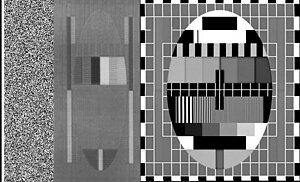A-MAC
Appearance
This article or section may have been copied and pasted from another location, possibly in violation of Wikipedia's copyright policy. (October 2021) |


In television electronics, A-MAC carries digital information: sound, and data-teletext on an FM subcarrier at 7 MHz. Since the vision bandwidth of a standard MAC signal is 8.4 MHz, the horizontal resolution on A-MAC has to be reduced to make room for the 7 MHz carrier. A-MAC has not been used in service.
Technical details
[edit]MAC transmits luminance and chrominance data separately in time rather than separately in frequency (as other analog television formats do, such as composite video).
Audio and Scrambling (selective access)
- Audio, in a format similar to NICAM was transmitted digitally rather than as an FM subcarrier.
- The MAC standard included a standard scrambling system, EuroCrypt, a precursor to the standard DVB-CSA encryption system.
TV transmission systems
[edit]- Analog high-definition television systems
- PAL, what MAC technology tried to replace
- SECAM, what MAC technology tried to replace
- A-MAC
- B-MAC
- C-MAC
- D-MAC
- E-MAC
- S-MAC
- D2-MAC
- HD-MAC, an early high-definition television standard allowing for 2048x1152 resolution.
- DVB-S, MAC technology was replaced by this standard
- DVB-T, MAC technology was replaced by this standard
External links
[edit]- Multiplexed Analogue Components in "Analog TV Broadcast Systems" by Paul Schlyter
